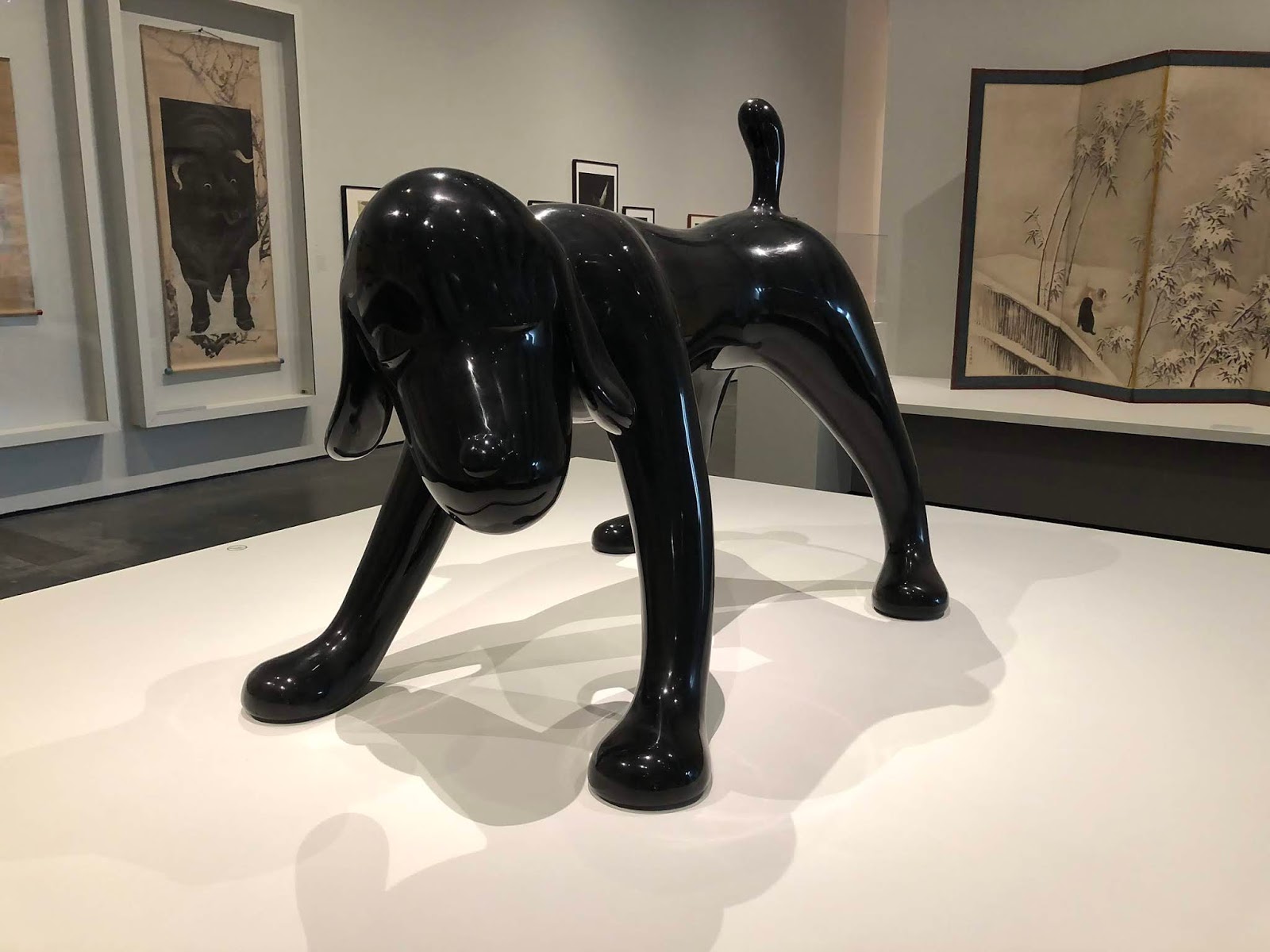 |
| Nara Yoshitomo, Black Hole Cosmic Dog, 1999 |
In Western art, animals are foils to humans or comic relief. In Japan animals are often the main subject of paintings or sculptures. A picture of an ox can be pious, philosophic, funny, or all of the above. LACMA's "Every Living Thing: Animals in Japanese Art," curated by Robert Singer and Kawai Masatomo, is a large show covering a lot of territory: nearly 200 objects in diverse media from 5th century to just about now. Despite its size, it's about the most family-friendly international loan exhibition you'll find. (Actually, the show is reduced by a hundred or so objects from the initial presentation at the National Gallery, Washington. DC had
Takashi Murakami's 82-foot painting, In the Land of the Dead, Stepping on the Tail of a Rainbow, owned by the Broad.)
 |
| Haniwa Horse, 6th century |
 |
| Pair of Inari Foxes, 13th-14th century. Photo: Kiyama Jinja |
One of the prize loans is a pair of Inari foxes from a Shinto shrine. They're said to be the earliest pair known in wood. The fox on the left holds the key to a granary; the one at right mouths a treasure ball.
 |
| Utagawa Yoshifuji, The Fifty-three Stations of the Tokaido: The Bewitched Cat of Okabe, about 1847-48 |
Utagawa Yoshifuji's woodblock print
The Bewitched Cat of Okabe (about 1847-48) treats a shape-shifting witch who devours unlucky travelers. Utagawa imagines the cat-witch as a monstrous feline face made out of cats. The eyes are cat toys, and the tongue is tied into the bow collar of Japanese pets. The print out-weirds Louis Wain and seems to reflect knowledge of the Archimboldesque meme of European art.
Many of the later works are intriguingly hybrid. Izumi Magouemon's boxwood
Skull and Snake (about 1892), conceived as a Western-style memento mori, won a prize at the 1893 World's Columbian Exposition, Chicago.
 |
| Maruyama Okyo, Cranes 1772 (one of two six-panel screens) |
Maruyama Okyo studied Western art and even pre-photographic stereographs. He was one of the first Japanese painters to observe nature with scientific precision. In
Cranes the hyperreal birds are presented without landscape backgrounds. Okyo's influence continued through the Meiji Period.
 |
| Shiokawa Bunrin's Fireflies at River's Edge, 19th century, and Korei Tameyoshi's Butterflies, 1872 |
 |
| Washimi Shungaku, Myriad Fishes, mid-to-late 19th century |
Washimi Shungaku's
Myriad Fishes (mid-to-late 19th century) is a 2017 gift of Lenore and Richard Wayne. Anticipating certain posters seen in Florida sports bars, it's an earnest attempt to grapple with the diversity of the natural world—a blend of natural history, caricature, allegory, and absurdity.
 |
| Yamamoto Kozan, Incense Burner in the Form of a Rabbit, about 1935 |
The deluxe minimalism of European Art Deco resonated with many Japanese artists. Witness Yamamoto Kozan's small, sleek
Rabbit—a white bronze incense burner—and a rabbit
Table Clock by Neya Churoku, probably 1920s or 1930s.
 |
| Neya Churoku, Table Clock with Rabbit Pounding Rice-Cakes on the Moon, about 1920s to 1930s |
 |
| Nakamura Kenji, Pair of Origami Crane Ornaments, about 1930s |
 |
| Unknown, Woman's Kimono-Style Jacket (Haori) with Rooster, Hens, and Chicks, 1912-26 |
 |
| Morita Shiryu, Dragon, 1965 |
"Every Living Thing" has two monumental works of calligraphy by the two greatest practitioners of the 1960s, Morita Shiryu and Inoue Yuichi. The former's
Dragon, a four-panel screen, employs such innovations as aluminum candy flake and alkyd varnish to express the character for "dragon" as a gestural pictograph.
 |
| Issey Miyake, Columbe (Dove), 1990 |
 |
| Maruyama Okyo, Puppies Among Bamboo in Snow, 1784 |
 |
| Dancing Fox (netsuke, ivory with staining and ink), 18th century |
 |
| teamLab, Sunflower Phoenix (single-channel digital video), 2017 |

















Comments
At least the Japanese Pavilion isn't being ripped down. But will the position of curator for Asian art at LACMA be combined with the curator of prints and drawings? Or maybe the curator of Islamic art? Or maybe with the head of the museum's janitorial services?
With the museum of Govan/Zumthor, one can never be sure what the hell is going on. Anything positive that is.
This is a glimpse of what the ongoing debacle of 5905 Wilshire Blvd has in store for everyone:
https://www.artsjournal.com/culturegrrl/2019/10/where-am-i-momas-impermanent-displays-of-its-permanent-collection-with-video.html